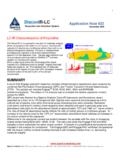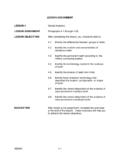Transcription of SLIC Superpixels - kev-smith.com
1 slic Superpixels ?Radhakrishna Achanta, Appu Shaji, Kevin Smith, Aurelien Lucchi,Pascal Fua, and Sabine S usstrunkSchool of Computer and Communication Sciences (IC) Ecole Polytechnique F edrale de Lausanne (EPFL) are becoming increasingly popular for use incomputer vision applications. However, there are few algorithms thatoutput a desired number of regular, compact Superpixels with a low com-putational overhead. We introduce a novel algorithm that clusters pixelsin the combined five-dimensional color and image plane space to effi-ciently generate compact, nearly uniform Superpixels . The simplicity ofour approach makes it extremely easy to use a lone parameter specifiesthe number of Superpixels and the efficiency of the algorithm makes itvery practical. Experiments show that our approach produces superpix-els at a lower computational cost while achieving a segmentation qualityequal to or greater than four state-of-the-art methods, as measured byboundary recall and under-segmentation error.
2 We also demonstrate thebenefits of our superpixel approach in contrast to existing methods fortwo tasks in which Superpixels have already been shown to increase per-formance over pixel-based IntroductionSuperpixels provide a convenient primitive from which to compute local im-age features. They capture redundancy in the image [1] and greatly reduce thecomplexity of subsequent image processing tasks. They have proved increasinglyuseful for applications such as depth estimation [2], image segmentation [3, 4],skeletonization [5], body model estimation [6], and object localization [7].For Superpixels to be useful they must be fast, easy to use, and produce highquality segmentations. Unfortunately, most state-of-the-art superpixel methodsdo not meet all these requirements. As we will demonstrate, they often sufferfrom a high computational cost, poor quality segmentation, inconsistent size andshape, or contain multiple difficult-to-tune approach we advocate in this work, while strikingly simple, addressesthese issues and produces high quality, compact, nearly uniform Superpixels moreefficiently than state-of-the-art methods [8, 9, 5, 10].
3 The algorithm we propose,simple linear iterative clustering( slic ) performs a local clustering of pixelsin the 5-D space defined by theL,a,bvalues of the CIELAB color space and?Please cite this paper as: Radhakrishna Achanta, Appu Shaji, Kevin Smith, Aure-lien Lucchi, Pascal Fua, and Sabine S usstrunk, slic Superpixels , EPFL TechnicalReport 149300, June et segmented using our algorithm into Superpixels of (approximate) size 64,256, and 1024 pixels. The Superpixels are compact, uniform in size, and adhere well toregion ,ypixel coordinates. A novel distance measure enforces compactness andregularity in the superpixel shapes, and seamlessly accomodates grayscale aswell as color images. slic is simple to implement and easily applied in practice the only parameter specifies the desired number of Superpixels . Experimentson the Berkeley benchmark dataset [11] show that slic is significantly moreefficient than competing methods, while producing segmentations of similar orbetter quality as measured by standard boundary recall and under-segmentationerror many vision tasks, compact and highly uniform Superpixels that respectimage boundaries, such as those generated by slic in Fig.
4 1, are desirable. Forinstance, graph-based models such as Conditional Random Fields (CRF) can seedramatic speed increases when switching from pixel-based graphs to superpix-els [3, 7], but loose or irregular Superpixels can degrade the performance. Localfeatures such as SIFT extracted from the image at superpixel locations becomeless meaningful and discriminative if the Superpixels are loose or irregular, andlearning statistics over cliques of two or more Superpixels can be effect can be seen when we compare the performance of slic superpixelsto competing methods for two vision tasks: object class recognition and medicalimage segmentation. In both cases, our approach results in similar or greaterperformance at a lower computational cost in comparison to existing BackgroundIn this section, we briefly review existing image segmentation algorithms andfocus on their suitability for producing Superpixels .
5 Not all them were designedfor this specific purpose and may lack the ability to control the size, number, andcompactness of the segments, but we include them in our discussion broadly classify superpixel algorithms into graph-based and gradient-ascent-based. Our survey, summarized in Table 1, considers the quality of segmentation,and the ability of these algorithm to control the size and number of Technical Report 1493003 Table of state of the art superpixel segmentation thenumber of pixels in the image. GS04 and QS09 do not offer explicit control of thenumber of Superpixels . SL08 complexity given in this table does not take into accountthe complexity of the boundary map computation. GS04 isO(N logN) complex but iscomparable in speed to slic for images less than million pixels while TP09 is alsoO(N) complex but is 10 times slower than slic for 481 321 pixel images. In the caseof QS09,dis a small constant (refer to [10] for details).
6 The number of parameterslisted in the table is the minimum required for typical SL08WS91MS02 TP09 QS09 SLICS uperpixel no. (.)N logN N3/2N2logN N logN Graph-based algorithmsIn graph based algorithms, each pixel is treated as a node in a graph, andedge weight between two nodes are set proportional to the similarity betweenthe pixels. Superpixel segments are extracted by effectively minimizing a costfunction defined on the Normalized cuts algorithm [9], recursively partitions a given graph usingcontour and texture cues, thereby globally minimizing a cost function defined onthe edges at the partition boundaries. It is the basis of the superpixel segmenta-tion scheme of [1] and [6] (NC05). NC05 has a complexity ofO(N32) [12], whereNis the number of pixels. There have been attempts to speed up the algorithm[13], but it remains computationally expensive for large images. The superpixelsfrom NC05 have been used in body model estimation [6] and skeletonization [5].
7 Fezenszwalb and Huttenlocher [8] (GS04) present another graph-based seg-mentation scheme that has been used to generate Superpixels . This algorithmperforms an agglomerative clustering of pixel nodes on a graph, such that eachsegment, or superpixel, is the shortest spanning tree of the constituent has been used for depth estimation [2]. It isO(NlogN) complex and isquite fast in practice as compared to NC05. However, unlike NC05, it does notoffer an explicit control on the number of Superpixels or their superpixel lattice is generated by [14] (SL08) by finding optimal vertical(horizontal) seams/paths that cut the image, within vertical (horizontal) stripsof pixels, using graph cuts on strips of the image. While SL08 allows control ofthe size, number, and compactness of the Superpixels , the quality and speed ofthe output strongly depend on pre-computed boundary et Gradient-ascent-based algorithmsStarting from an initial rough clustering, during each iteration gradient ascentmethods refine the clusters from the previous iteration to obtain better segmen-tation until [15] (MS02) is a mode-seeking algorithm that generates imagesegments by recursively moving to the kernel smoothed centroid for every datapoint in the pixel feature space, effectively performing a gradient ascent [10].
8 Thegenerated segments/ Superpixels can be large or small based on the input kernelparameters, but there is no direct control over the number, size, or compactnessof the resulting [10] (QS08) is also a mode-seeking segmentation scheme likeMean-shift, but is faster in practice. It moves each point in the feature space tothe nearest neighbor that increases the Parzen density estimate. The algorithmis non-iterative and, like Mean-shift, does not allow one to explicitly control thesize or number of Superpixels . Superpixels from quick-shift have been used inapplications like object localization [7] and motion segmentation [16].We include two other segmentation methods in the category of gradient as-cent algorithms: Watersheds [17] (WS91) and Turbopixels [12] (TP09). Generalwatershed algorithms perform gradient ascent from local minima in the imageplane in order to obtain watersheds, lines that separate catchment and Soille [17] propose a fast version based on queuing of [3] applies graph cuts to the graph built on the Superpixels output bythis generates Superpixels by progressively dilating a given number of seedsin the image plane, using computationally efficient level-set based geometricflow.
9 The geometric flow relies on local image gradients, and aims to distributesuperpixels evenly on image plane. Unlike WS91, Superpixels from TP09 are con-strained to have uniform size, compactness, and adherence to object slic segmentation algorithmOur approach generates Superpixels by clustering pixels based on their colorsimilarity and proximity in the image plane. This is done in the five-dimensional[labxy] space, where [lab] is the pixel color vector in CIELAB color space, whichis widely considered as perceptually uniform for small color distances, andxyisthe pixel position. While the maximum possible distance between two colors inthe CIELAB space (assuming sRGB input images) is limited, the spatial distancein thexyplane depends on the image size. It is not possible to simply use theEuclidean distance in this 5D space without normalizing the spatial order to cluster pixels in this 5D space, we therefore introduce a new distancemeasure that considers superpixel size.
10 Using it, we enforce color similarity aswell as pixel proximity in this 5D space such that the expected cluster sizes andtheir spatial extent are approximately Technical Report Distance measureOur algorithm takes as input a desired number of approximately equally-sizedsuperpixelsK. For an image withNpixels, the approximate size of each super-pixel is thereforeN/Kpixels. For roughly equally sized Superpixels there wouldbe a superpixel center at every grid intervalS= the onset of our algorithm, we chooseKsuperpixel cluster centersCk=[lk,ak,bk,xk,yk]Twithk= [1,K] at regular grid intervalsS. Since the spatialextent of any superpixel is approximatelyS2(the approximate area of a super-pixel), we can safely assume that pixels that are associated with this clustercenter lie within a 2S 2 Sarea around the superpixel center on becomes the search area for the pixels nearest to each cluster distances in CIELAB color space are perceptually meaningful forsmall distances (min Eq.)






